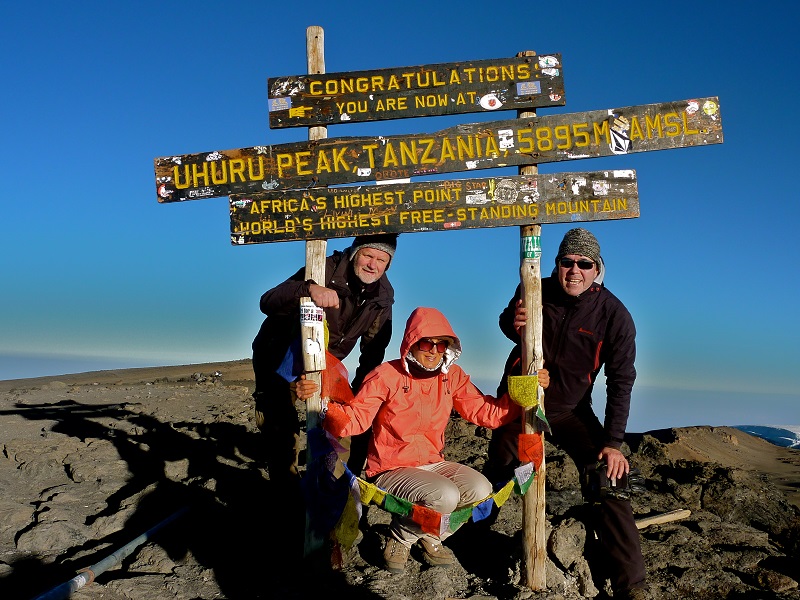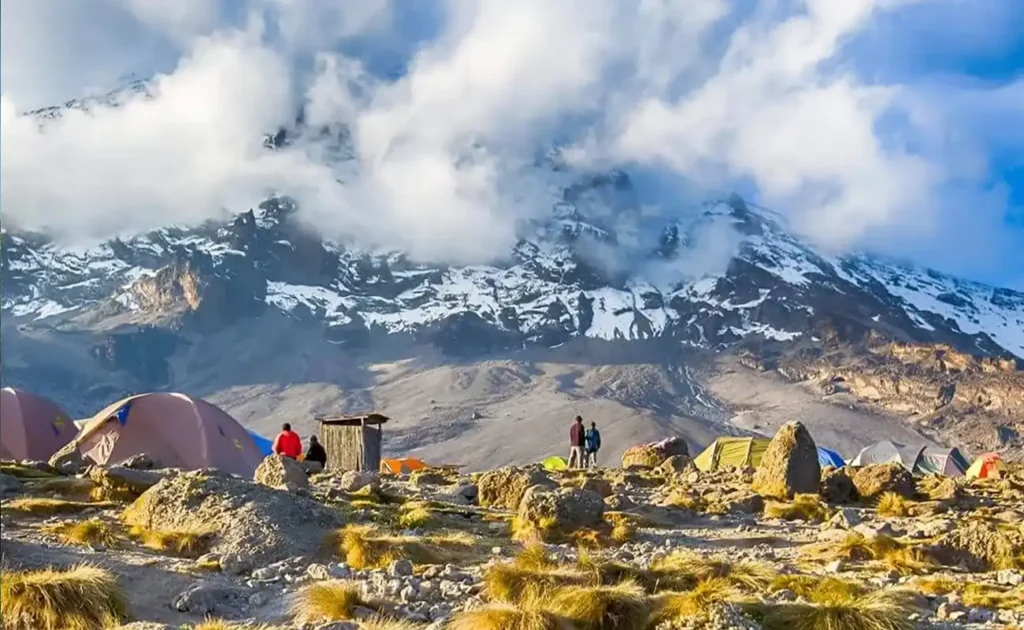Reaching the summit of Kilimanjaro is an ambition, with nearly 35,000 climbers striving to conquer its heights each year. However, around 40% of trekkers fail due to altitude sickness, amidst breathtaking landscapes. How prepared are you to face such a formidable challenge?
The journey up Kilimanjaro encompasses five distinct climates, reflecting the mountain’s diverse ecosystem. Glacial, snowy conditions await at the top, while lower slopes introduce climbers to lush rainforests. Understanding these transitions and planning acclimatization days significantly enhance the chances of a successful ascent.

Understanding the Physical Challenges of Climbing Kilimanjaro
Kilimanjaro’s towering heights pose significant physical challenges for climbers. One of the most notable hurdles is altitude sickness. As you climb, the reduced oxygen levels can make breathing difficult. Trekkers often experience headaches, dizziness, and nausea. These symptoms can become more serious the higher you go.
The trail itself is tough, with diverse landscapes that test stamina. First, you’ll trek through lush forests brimming with wildlife. Next, you’ll navigate rocky paths and steep inclines. Each terrain requires different skills and muscles. Preparing for such variations is vital for a successful ascent.
Another challenge is the sheer duration of the climb. Most routes take around seven days. This requires consistent energy and endurance. Climbers must pace themselves carefully. Remaining hydrated and eating well are key strategies.
Weather conditions add another layer of complexity. Temperatures can vary drastically from base to summit. At the top, you’ll face freezing winds and snow. Proper gear is essential to protect against these extremes. Layers help manage body heat effectively.
10 Things I Wish I Knew BEFORE Climbing Mt Kilimanjaro! | Follow Alice | 4K
The Impact of Altitude on the Body
Altitude affects the body significantly as you climb higher. The air gets thinner, reducing the amount of oxygen available. This change can make breathing more difficult and strenuous. As a result, climbers often feel short of breath. Symptoms like fatigue and dizziness can occur even with mild exertion.
Altitude sickness is a common challenge for climbers. The symptoms include headaches, nausea, and loss of appetite. In severe cases, it can escalate to High Altitude Pulmonary Edema (HAPE) or High Altitude Cerebral Edema (HACE). Immediate descent becomes necessary if these conditions develop. Knowing how to recognize these signs is crucial for safety.
Acclimatization strategies can help mitigate the effects of altitude. These include ascending slowly and taking rest days. Staying hydrated is also key, as dehydration worsens altitude sickness. Some climbers use medications like acetazolamide to aid acclimatization. Planning for these measures can improve chances of a successful climb.
Understanding how altitude impacts the body will help you prepare better. Here are some common symptoms to watch for:
- Shortness of breath
- Headaches
- Nausea
- Fatigue
- Dizziness
Physical Fitness Requirements
Climbing Kilimanjaro requires good physical fitness. Even though it’s not a technical climb, the trek is still demanding. You need strong muscles for the long hikes and steep ascents. Also, aerobic fitness helps your body cope with lower oxygen levels. Preparing your body ensures you can handle the strain of the climb.
It’s essential to train several months before your trek. Focus on building endurance through cardio exercises. Activities like running, cycling, or swimming are excellent choices. Strength training helps, too, especially for your legs and core. Regular hiking on varied terrain can also prepare you for Kilimanjaro.
Flexibility and balance exercises are important as well. Yoga and stretching routines can improve muscle flexibility. These exercises reduce the risk of injuries during the climb. They also help with balance on uneven paths. Combining these routines can create a well-rounded training program.
A fitness plan could include:
- Cardio activities three times a week
- Strength training twice a week
- Regular hikes with a loaded backpack
- Yoga or stretching exercises
Duration and Terrain Types
Trekking up Mount Kilimanjaro typically takes about seven to nine days, depending on the route chosen. The duration allows climbers to acclimatize to the altitude. Faster ascents can increase the risk of altitude sickness. By taking more time, climbers can enjoy the varied landscapes along the way. Each day presents new challenges and scenery.
The journey begins in lush rainforests at the base of the mountain. This part of the trek is shaded and humid. The trails here are often muddy and can be slippery. You’ll see towering trees and diverse wildlife. This vibrant environment levels off as you ascend.
Next, climbers transition to the moorland zone. The vegetation becomes sparse, with heather and small bushes. The paths are rockier and the air cooler. This section requires careful footing. The landscape starts to appear more rugged.
Further up, you enter the alpine desert zone. The terrain here is harsh and barren. Strong winds and intense sunlight are common. The rocky path can be challenging, with loose stones underfoot. Staying hydrated is critical in this environment.
The final stretch is the arctic summit zone. This area features glaciers and snow. Temperatures drop significantly, and breathing becomes more difficult. The ground is icy and uneven, demanding focus and determination. Reaching the summit is a rewarding and unforgettable experience.
Mental Preparation for Climbing Kilimanjaro
Mental strength is as crucial as physical fitness when climbing Kilimanjaro. Preparing your mind can make the difference between reaching the summit and turning back. It begins with setting realistic expectations. The climb is challenging, and conditions can be tough. A strong mindset helps tackle these obstacles effectively.
Visualization techniques are powerful tools for mental preparation. Picture yourself overcoming each stage of the hike successfully. Imagine the sense of achievement upon reaching the summit. This positive imagery builds confidence and motivation. It helps reinforce your determination in challenging moments.
Stress management is key to maintaining mental focus. Stress can weaken decision-making and sap energy. Practice relaxation techniques such as deep breathing or meditation. These skills can calm the mind and help you handle pressure. Developing these habits before the climb is beneficial.
Having a strong support system can boost morale. Climbing with friends or a team provides encouragement. Sharing the experience eases the weight of the challenge. Talking about fears and anxieties can also be comforting. Communicating openly with your group strengthens bonds.
Set manageable daily goals during the trek. Focus on small, attainable steps rather than the entire climb. Breaking the journey into smaller parts keeps spirits high. Celebrating these smaller milestones encourages continued effort. Remember to enjoy the adventure, not just the destination.
Navigating the Different Routes and Their Difficulties
When planning to climb Kilimanjaro, choosing the right route is vital. The mountain offers several paths, each with unique challenges and scenery. The Marangu Route, known as the “Coca-Cola Route,” is one of the most popular. It’s relatively easier and has huts for accommodation. However, its popularity means it can be crowded.
The Machame Route, also called the “Whiskey Route,” is more challenging but incredibly scenic. It involves steeper climbs and longer days. This route offers varied landscapes, from rainforests to rocky ridges. The extra effort required rewards climbers with stunning views. Machame has a higher success rate due to its longer acclimatization period.
For those seeking a quieter path, the Rongai Route is an excellent choice. This route approaches Kilimanjaro from the north and is less traveled. It features gentler gradients but fewer acclimatization opportunities. Climbers can enjoy solitude and a unique landscape. The descent typically follows the Marangu Route.
The Lemosho Route is known for its beautiful scenery and lower traffic. It starts on the western side of the mountain and merges with the Machame Route. This longer route offers great acclimatization time, boosting success rates. The varied terrain includes lush forests, moorlands, and glaciers. It’s an excellent option for those with more time.
The Northern Circuit Route is the longest and often the most successful. It provides the most acclimatization time, making it ideal for those wary of altitude sickness. The route circles around the north before approaching the summit. It offers stunning, less-seen views of the mountain. This path is perfect for those who enjoy extended hikes and tranquility.
Weather Conditions on Kilimanjaro and Their Effects
The weather on Kilimanjaro changes drastically from base to summit. At the bottom, you’ll find a warm, tropical climate. This area experiences regular rain showers, making trails muddy and slick. As you ascend, the air becomes cooler and drier. Climbers should be prepared for these rapid transitions.
In the moorland zone, temperatures drop further. Expect cooler days and chilly nights here. The winds begin to pick up, which can feel harsh against the face. Dressing in layers is essential to adapt quickly to these shifts. The unpredictable weather demands smart preparation.
The alpine desert zone sees even more severe conditions. Daytime tends to be sunny but cold due to high winds and open exposure. Nights are particularly freezing as the temperature plummets below zero degrees Celsius. Climbers must protect themselves from sunburn and wind chill alike. Hydration is vital since dry air can lead to dehydration.
At the summit, weather conditions become extreme with snow and ice coverage year-round. Temperatures can fall well below freezing any time of day or night. These icy conditions require careful navigation over slippery terrain while conserving heat through proper clothing layers made of insulating materials like wool or synthetic fibers designed for cold climates.
Certain months bring distinct weather patterns that should guide your planning:
- January-March: Warmer with some rain; less crowded
- April-May: Heavy rains; fewer climbers (less recommended)
- June-October: Drier; popular months
- November-December: Increased rainfall; fewer crowds
Essential Gear and Supplies for the Climb
Tackling Mount Kilimanjaro requires the right gear and supplies. Proper clothing is critical to handle varying weather conditions. Layering is the best strategy. Start with moisture-wicking base layers, add insulating mid-layers, and finish with a waterproof outer layer. This combination will keep you warm and dry throughout the climb.
A sturdy pair of hiking boots is a must. They should be well-broken-in to prevent blisters. High-ankle support and waterproofing are beneficial. Along with boots, comfortable socks designed for trekking are important. Make sure to bring enough pairs to change frequently.
Other vital gear includes a quality sleeping bag rated for cold temperatures. Nights can be extremely cold, so having a bag that can withstand below-freezing temperatures is crucial. You’ll also need a good backpack to carry essentials. Look for one with strong support and multiple compartments for easy organization.
Don’t forget essential accessories such as a headlamp, trekking poles, and sun protection. A headlamp is useful for early-morning summit attempts. Trekking poles help with balance and reduce strain on your knees. Sunglasses, sunscreen, and a wide-brimmed hat are necessary to guard against the sun’s harsh rays.
Here’s a basic packing list:
- Moisture-wicking base layers
- Insulating mid-layers
- Waterproof outer layers
- Sturdy hiking boots
- Trekking socks
- Cold weather sleeping bag
- Supportive backpack
- Headlamp
- Trekking poles
- Sun protection
Key Takeaways
- Kilimanjaro’s diverse terrain requires varied physical and mental preparation.
- Altitude sickness is a common challenge many climbers face on the ascent.
- Layered clothing helps manage Kilimanjaro’s changing weather conditions effectively.
- Quality gear, like boots and sleeping bags, ensures safety and comfort.
- Proper acclimatization boosts the odds of a successful climb to the summit.




